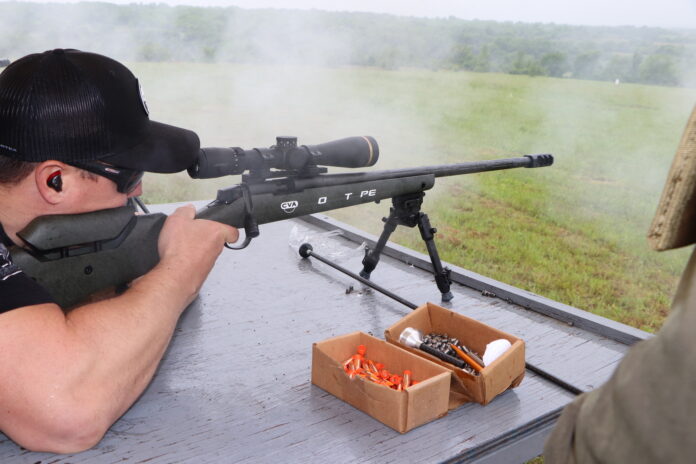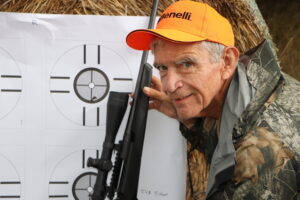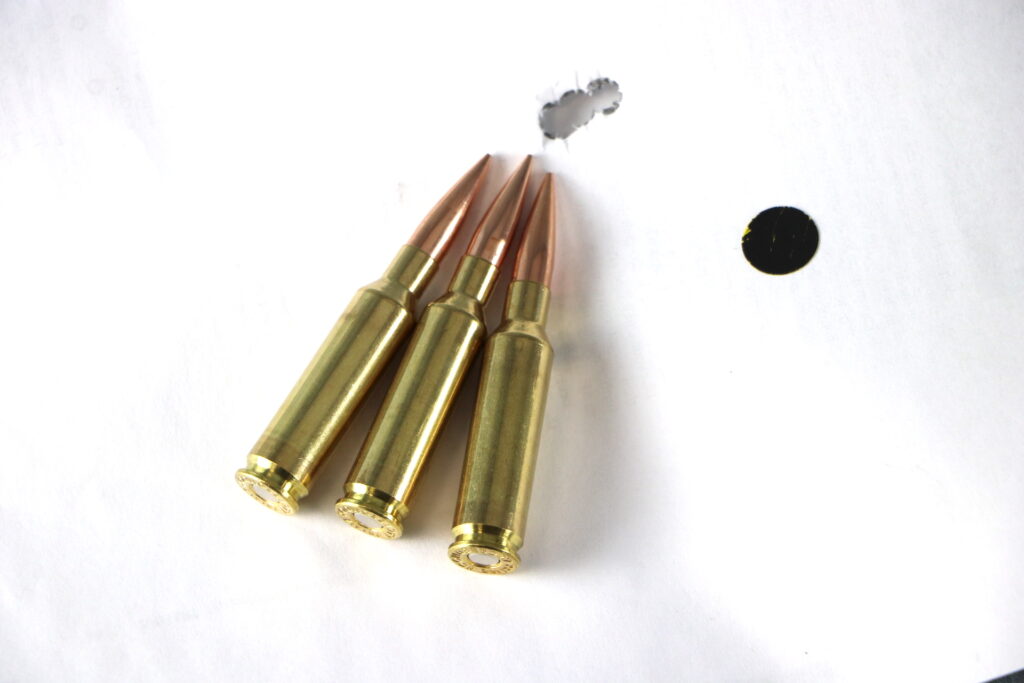
BY STEVE COMUS
One shot, one deer. One shot, one pig. The concept is simple, but realizing it is, well, maybe not so much.
As the focus on longer and longer-range shooting continues, the industry is redefining what “accuracy” means. What was “good enough” years ago now is unacceptable to many shooters.
When it comes to hunting, there can be a difference between “effective” accuracy and “acceptable” accuracy. Hunters are and always have been advised to accept better than just effective accuracy because effective accuracy is a minimum quantity.
That’s because the object of a shot while hunting is to put the bullet into a place in the animal that will dispatch it quickly.
To understand this, imagine that the kill zone in a mature bull Rocky Mountain elk is 14 inches, maybe a little more in one direction or another from the center because of the way the heart/lung area is shaped.
This means that effective accuracy is anything that puts the bullet into that 14-inch area at the shot. If the shot is taken at 300 yards or less, then it means that a rifle that can put every shot into more or less a 4½-inch group at 100 yards would be “good enough.”
Granted, there are many factors like shooter ability, wind and other atmospheric conditions that also weigh-in on where the bullet goes, but for this discussion, we’ll assume that all of the other factors are equal to be able to discuss how the inherent accuracy of the rifle fits into the overall picture.
Obviously, no ethical hunter would go afield and attempt a 300-yard shot at an elk with a rifle that delivers only a 4½-inch group off the bench at 100 yards. Even if we figure that the other factors account for half of the accuracy in the field for an accomplished rifleman, it means that an “acceptable” rifle would be one that delivers no larger than 2¼-inch groups at 100 yards off the bench.

But that’s the “minimal” acceptable accuracy under ideal conditions. In real world terms, it, then, is prudent to cut that in half to afford enough latitude to be certain that a careful shot will do its job, every time. Now, we’re talking about 1 1/8-inch groups off the bench at 100 yards. Is this starting to sound familiar since hunters generally consider a rifle that will shoot one inch at 100 yards is an okay hunting rifle?
As recently as a few decades ago, riflemakers considered 1½-inch groups at 100 yards off the bench were sufficient for a hunting rifle. In recent years, some of the larger manufacturers offer specific models that are guaranteed to deliver one inch or better groups off the bench at 100 yards with quality ammo.
Some of the custom and semi-custom companies now are guaranteeing half-inch or better groups with specific ammo. These rifles cost several times as much as a typical rifle and the price is worth it for those who demand the best accuracy money can buy.
As mentioned above, there is more to field accuracy than the inherent accuracy of the rifle. However, field accuracy never can be better than the inherent accuracy of the rifle itself.
Each rifle is a study unto itself, which means that some regular production line rifles actually deliver superb accuracy, even though two or three rifles from the same production run in the same factory will deliver three different levels of accuracy with the same ammo under the same circumstances.
So, how does one calculate the accuracy of a given hunting rifle that is being shot by an individual hunter? Shoot groups off the bench with the sights and ammo that will be used on the hunt.
Here, it is crucial to keep the ultimate mission in mind, which is to put a single bullet into the kill zone of a game animal in the wild. All of the calculations need to result in a rig that will accomplish this single mission.
With that in mind, how many shots need to be in the group? The National Rifle Association of America’s regime calls for five consecutive, five-shot groups at 100 yards off the bench. I am told that the NRA came to this routine because it is somehow statistically as relevant as is practical. I am neither a mathematician nor a statistician, so I take them at their word.
However, I have shot with a number of the NRA staff and can say with authority that some of them can shoot better groups with the same rifle and ammo than others. Nothing is absolute.

It is not convenient for most hunters to shoot 25 rounds from each type of load being considered to figure out how they are shooting their personal rifles. Hence, it also is common in the industry to consider three-shot groups for hunting rifles to be good indicators of how and where the rifle is shooting.
After all, regardless of how many shots are in the group, the timing of the shots can matter a bunch, especially for rifles with thin, whippy barrels. The group can grow quickly as the barrel heats up for some rigs.
Back to the field situation. Where the first shot from a cold barrel goes is all that matters when squeezing the trigger while aiming at a game animal. If that shot hits its mark, all else is moot.
Hence, for hunters, attention needs to be paid about where that first shot from a cold barrel goes. It also is handy to know where quick, follow-up shots go, as well.
For example, I have a Remington Model 7 rifle in 7mm-08 Rem. with a short, whippy barrel that, when shooting quick three-shot groups off the bench will put two overlapping holes in the target at 100 yards and then the third shot is exactly one-inch higher than the first two.
When shooting a shot and allowing the barrel to cool between shots, three-shot groups are under a half-inch with that rifle. I have shot a number of wild pigs and deer with that rifle, and never have had to take a second shot on a hunt, even though the average distance has been just a tad over 200 yards.
So, what is acceptable accuracy? Depends on the distance of the shot and performance of the bullet. For example, the Model 94 Winchester .30-30 was considered America’s “deer rifle” for decades, even though field accuracy with iron barrel sights tended to be around 2½ inches at 100 yards off the bench. That’s because it was assumed that shots would not be longer than 100 yards, and many were half that.
If shots on game are limited to 300 yards or less, then 1½ inches at 100 yards can work fine. One inch is better, however, and a half-inch is ideal.
Bottom line: a hunting rifle cannot be too accurate. But since perfection is a goal rather than a requirement, all a hunter can do is to focus on those things over which he or she has control and assure that they deliver effective performance. That leaves a little wiggle room for other unexpected factors so that the game animal is dispatched quickly at the shot.
Steve Comus is a nationally recognized hunting editor with Safari Club International and a WON Guns and Hunting Guns Editor. His column appears every other week in WON and he can be reached at scomus@cox.net.


